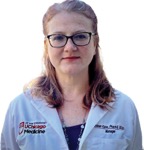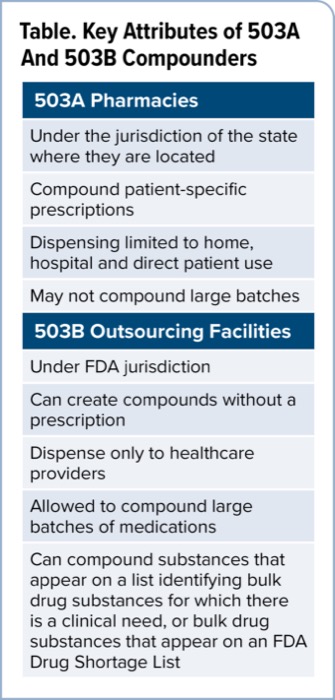
Cooperation among 503A and 503B compounders will be needed to navigate dangerous regulatory shoals in 2025, experts said at the APhA 2025 Annual Meeting & Exposition, in Nashville, Tenn.
Both entities “can work together,” said Kathleen J. Kane, PharmD, BCSCP, an assistant director of pharmacy, compounding integrity and compounding regulatory compliance at the University of Chicago Medical Center. “A lot of people see each as two separate entities that have nothing to do with each other, but both kinds of compounders can [collaborate] to help solve issues that affect patients and health systems.” In order to do this, “503A pharmacies need to be able to identify quality 503Bs.”
Dr. Kane first delineated the differences between 503B outsourcing facilities and 503A pharmacies, before offering an example of how they can work in tandem (Table).
| Table. Key Attributes of 503A And 503B Compounders |
| 503A Pharmacies |
|---|
| Under the jurisdiction of the state where they are located |
| Compound patient-specific prescriptions |
| Dispensing limited to home, hospital and direct patient use |
| May not compound large batches |
| 503B Outsourcing Facilities |
| Under FDA jurisdiction |
| Can create compounds without a prescription |
| Dispense only to healthcare providers |
| Allowed to compound large batches of medications |
| Can compound substances that appear on a list identifying bulk drug substances for which there is a clinical need, or bulk drug substances that appear on an FDA Drug Shortage List |
A key area in which 503As and 503Bs complement each other is the ability to meet demand during a drug shortage. The capability of 503Bs to make large batches of drugs without needing individual patient prescriptions means that they can be crucial suppliers of drugs to 503A pharmacies, and their patients, during shortages.
Dr. Kane advocated for pharmacists at 503A facilities to familiarize themselves with tools and organizations that will help them vet the quality of 503B outsourcing facilities. She recommended the FDA Compounding Quality Center of Excellence website (bit.ly/4j2e4FA) as the place to start.
“The FDA does a really good job. They definitely inspect with a frequency that makes me feel good,” she said. “I also encourage pharmacists to do their own due diligence, ask to visit the 503B facilities, and to see the paperwork that shows they are adhering to the FDA’s standards.”
503Bs Under Threat
Even with effective strategies to ensure that a quality 503B is selected, Dr. Kane’s co-presenter, Marc Wagner, PharmD, JD, MBA, an associate at Baker & Hostetler LLP, in Washington, D.C., warned that 503Bs’ ability to supply 503As and other healthcare providers is under threat.
“There was longstanding guidance that was in place prior to Jan. 7, 2025, in which the FDA said an API [active pharmaceutical ingredient] could be nominated to be considered for the 503B bulks list. The FDA would briefly review that nomination. If it contained all of the information that the FDA was requesting, and the FDA didn't have any safety concerns for the use of that API, they would place it on an interim category list called Category 1. A 503B outsourcing facility could compound a Category 1 drug as long as they meet all of the other conditions of Section 503B.”
The FDA released new guidance on Jan. 7, indicating that it will no longer categorize bulk drug substance nominations. This means that any bulk drug substance that was not nominated before Jan. 7 does not have an opportunity to get on this interim category list. The only way for an outsourcing facility to compound using one of those bulk drug substances would be either that the bulk drug substance is a component of an FDA-approved drug product that appears on the drug shortage list or the FDA takes final action on that nomination, going through notice, comment, rulemaking, a proposal and finalization to the 503B final bulks list.
“This move was shocking because currently there are only five bulk drug substances that are on the 503B final bulks list, and that is less than 1% of all of the bulk drug substances that have been nominated,” Dr. Wagner said.
Although the reason for the change in guidance is unknown, Dr. Wagner pointed out that the nomination process “is very rigorous; it almost mimics that of a drug approval. So they may have a lack of resources to categorize new substances.”
However, this strategy “will hamper compounding at the higher quality standard that 503Bs adhere to, due to their oversight from the FDA,” he stressed. “This will force healthcare organizations to rely more on 503A facilities, which have a lower capacity for output and generally have a lower quality standard. Ultimately, this policy is contrary to putting quality and patient safety as a top priority.”
To ensure that patients and health systems can continue to receive the benefits of 503B compounding, Dr. Wagner indicated that trade associations such as the Outsourcing Facilities Association—the trade association representing FDA-registered 503B outsourcing facilities—are advocating for changes to the Jan. 7 agency guidance.
Drs. Kane and Wagner reported no relevant financial disclosures.
{RELATED-HORIZONTAL}

